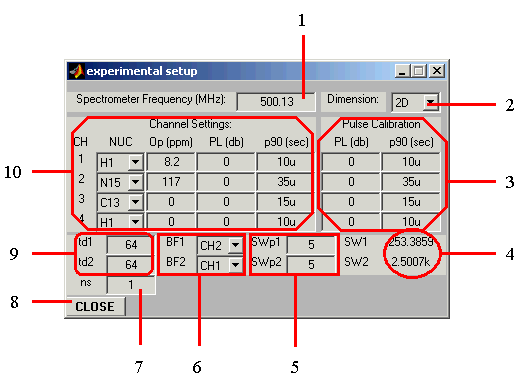The Experimental Setup Window

- Spectrometer Frequency: Enter desired spectrometer (1H) frequency in MHz.
- Dimension: Use this pulldown button to select the dimension of the experiment: 1D, 2D,
or 3D (coming soon).
- Pulse Calibration tool: This is a built-in calculator that imitates pulse/power level calibration,
that might be necessary if various power levels are used in the pulse sequence.
Given the reference power level and the 90-deg pulse length defined in Channel Settings (10), this
tool allows determination of a 90-deg. pulse corresponding to the desired power level, or vice versa,
determines power level, given the desired 90-deg pulse length. To perform the calculation:
- select the channel you want to perform the calibration for;
- make sure the reference PL and p90 are set properly in Channel Settings for this channel, see (10) below;
- to calibrate p90, type the desired PL value (in dB) in the corresponding box in the left
column, then hit Enter -- the desired pulse length appears in the right column;
- to calibrate PL, type the desired p90 in the corresponding box in the right column, then
hit Enter -- the desired power level value appears in the left column;
Use these calibrated values to set the corresponding parameters in the Program Parameters Window.
- Spectral Widths display Displays selected spectral widths (in Hz) in both spectral dimensions.
- Spectral Widths Selection tool Enter desired spectral widths (in ppm) in F1 and F2.
- CBasic Frequency Selection tool: Use these pull-down menus to select basic frequency for each spectral
dimension (you celect it via selecting the channel or gyromagnetic ratio associated with each
spectral dimension): e.g. both BF1 and BF2 should be selected as CH1 (1H channel) for a homonuclear
(proton) experiment, while BF1 should be set to 15N channel (e.g. CH2 in the example shownon the picture)
for a heteronuclear 1H{15N} experiment.
- Number of Scans: Use this box to enter number of scans for the experiment (default ns=1).
- Close button: Closes the Experimental Setup window.
- Size of Time-Domains: Enter number of time data points to be collected in each dimension.
The number of time-domain rows (boxes) equals the selected dimension of the experiment.
- Channel Settings tool: Up to four channels can be used in VNMR. Use this tool to define for each
channel (as necessary):
- NUC: Type of nucleus the channel is tuned to;
- Op: Carrier position (in ppm) for this channel;
- PL: Reference power level (in dB), ex.plc(channel#);
- p90: Length of a 90-degree pulse, ex.p90c(channel#), corresponding to the reference power level (PL);
Note: If several channels are tuned to the same nucleus (e.g. 1H), then the carrier position (Op) for only one of them can be set to a nonzero value, the rest of these channels must have Op set to 0.
BACK TO VNMR MAIN WINDOW
BACK TO VNMR MANUAL
Back to top
Page designed by David Fushman & Peter Nicholas. Modified 11/26/2002.

